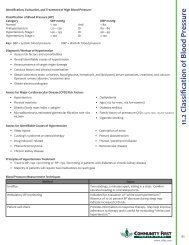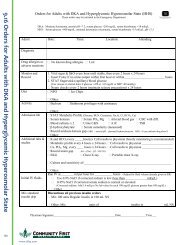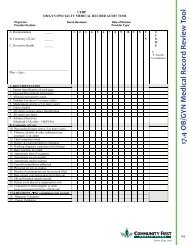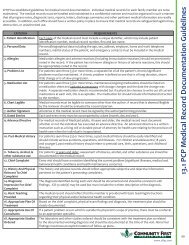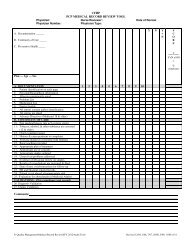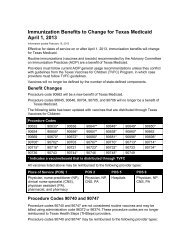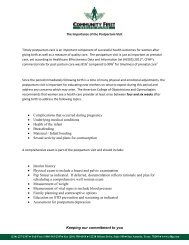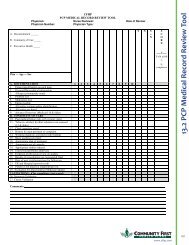Full Clinical Guidelines - Community First Health Plans.
Full Clinical Guidelines - Community First Health Plans.
Full Clinical Guidelines - Community First Health Plans.
Create successful ePaper yourself
Turn your PDF publications into a flip-book with our unique Google optimized e-Paper software.
16.2.3 Immunization Catch-up Schedule<br />
FIGURE 3. Catch-up immunization schedule for persons aged 4 months through 18 years who start late or who are more than 1 month behind —United States • 2012<br />
The figure below provides catch-up schedules and minimum intervals between doses for children whose vaccinations have been delayed. A vaccine series<br />
does not need to be restarted, regardless of the time that has elapsed between doses. Use the section appropriate for the child’s age. Always use this table in<br />
conjunction with the accompanying childhood and adolescent immunization schedules (Figures 1 and 2) and their respective footnotes.<br />
Vaccine<br />
Minimum Age<br />
for Dose 1<br />
Hepatitis B Birth 4 weeks<br />
Persons aged 4 months through 6 years<br />
Minimum Interval Between Doses<br />
Dose 1 to dose 2 Dose 2 to dose 3 Dose 3 to dose 4 Dose 4 to dose 5<br />
8 weeks<br />
and at least 16 weeks after first dose; minimum age for<br />
the final dose is 24 weeks<br />
Rotavirus 1 6 weeks 4 weeks 4 weeks 1<br />
Diphtheria, tetanus, pertussis 2 6 weeks 4 weeks 4 weeks 6 months 6 months 2<br />
Haemophilus influenzae<br />
type b 3<br />
Pneumococcal 4<br />
6 weeks<br />
6 weeks<br />
4 weeks<br />
if first dose administered at younger than age 12 months<br />
8 weeks (as final dose)<br />
if first dose administered at age 12–14 months<br />
No further doses needed<br />
if first dose administered at age 15 months or older<br />
4 weeks<br />
if first dose administered at younger than age 12 months<br />
8 weeks (as final dose for healthy children)<br />
if first dose administered at age 12 months or older or current<br />
age 24 through 59 months<br />
No further doses needed<br />
for healthy children if first dose administered at<br />
age 24 months or older<br />
4 weeks 3<br />
if current age is younger than 12 months<br />
8 weeks (as final dose) 3<br />
if current age is 12 months or older and first dose<br />
administered at younger than age 12 months and second<br />
dose administered at younger than 15 months<br />
No further doses needed<br />
if previous dose administered at age 15 months or older<br />
4 weeks<br />
if current age is younger than 12 months<br />
8 weeks (as final dose for healthy children)<br />
if current age is 12 months or older<br />
No further doses needed<br />
for healthy children if previous dose administered at<br />
age 24 months or older<br />
Inactivated poliovirus 5 6 weeks 4 weeks 4 weeks<br />
Meningococcal 6 9 months 8 weeks 6<br />
Measles, mumps, rubella 7 12 months 4 weeks<br />
Varicella 8 12 months 3 months<br />
Hepatitis A 12 months 6 months<br />
Tetanus, diphtheria/ tetanus,<br />
diphtheria, pertussis 9 7 years 9 4 weeks<br />
Persons aged 7 through 18 years<br />
4 weeks<br />
if first dose administered at younger than age 12 months<br />
6 months<br />
if first dose administered at 12 months or older<br />
Human papillomavirus 10 9 years Routine dosing intervals are recommended 10<br />
Hepatitis A 12 months 6 months<br />
Hepatitis B Birth 4 weeks<br />
8 weeks<br />
(and at least 16 weeks after first dose)<br />
8 weeks (as final dose)<br />
This dose only necessary<br />
for children aged 12<br />
months through 59 months<br />
who received 3 doses<br />
before age 12 months<br />
8 weeks (as final dose)<br />
This dose only necessary<br />
for children aged 12<br />
months through 59 months<br />
who received 3 doses<br />
before age 12 months or<br />
for children at high risk<br />
who received 3 doses at<br />
any age<br />
6 months 5<br />
minimum age 4 years for<br />
final dose<br />
6 months<br />
if first dose administered at<br />
younger than<br />
age 12 months<br />
Inactivated poliovirus 5 6 weeks 4 weeks 4 weeks 5 6 months 5<br />
Meningococcal 6 9 months 8 weeks 6<br />
Measles, mumps, rubella 7 12 months 4 weeks<br />
Varicella 8<br />
12 months<br />
3 months<br />
if person is younger than age 13 years<br />
4 weeks<br />
if person is aged 13 years or older<br />
1. Rotavirus (RV) vaccines (RV-1 [Rotarix] and RV-5 [Rota Teq]).<br />
• The maximum age for the first dose in the series is 14 weeks, 6 days; and<br />
8 months, 0 days for the final dose in the series. Vaccination should not be<br />
initiated for infants aged 15 weeks, 0 days or older.<br />
• If RV-1 was administered for the first and second doses, a third dose is not<br />
indicated.<br />
2. Diphtheria and tetanus toxoids and acellular pertussis (DTaP) vaccine.<br />
• The fifth dose is not necessary if the fourth dose was administered at age 4<br />
years or older.<br />
3. Haemophilus influenzae type b (Hib) conjugate vaccine.<br />
• Hib vaccine should be considered for unvaccinated persons aged 5 years or<br />
older who have sickle cell disease, leukemia, human immunodeficiency virus<br />
(HIV) infection, or anatomic/functional asplenia.<br />
• If the first 2 doses were PRP-OMP (PedvaxHIB or Comvax) and were<br />
administered at age 11 months or younger, the third (and final) dose should<br />
be administered at age 12 through 15 months and at least 8 weeks after the<br />
second dose.<br />
• If the first dose was administered at age 7 through 11 months, administer<br />
the second dose at least 4 weeks later and a final dose at age 12 through 15<br />
months.<br />
4. Pneumococcal vaccines. (Minimum age: 6 weeks for pneumococcal conjugate<br />
vaccine [PCV]; 2 years for pneumococcal polysaccharide vaccine [PPSV])<br />
• For children aged 24 through 71 months with underlying medical conditions,<br />
administer 1 dose of PCV if 3 doses of PCV were received previously, or<br />
administer 2 doses of PCV at least 8 weeks apart if fewer than 3 doses of<br />
PCV were received previously.<br />
• A single dose of PCV may be administered to certain children aged 6 through 18<br />
years with underlying medical conditions. See age-specific schedules for details.<br />
• Administer PPSV to children aged 2 years or older with certain underlying<br />
medical conditions. See MMWR 2010:59(No. RR-11), available at http://<br />
www.cdc.gov/mmwr/pdf/rr/rr5911.pdf.<br />
5. Inactivated poliovirus vaccine (IPV).<br />
• A fourth dose is not necessary if the third dose was administered at age 4<br />
years or older and at least 6 months after the previous dose.<br />
• In the first 6 months of life, minimum age and minimum intervals are only<br />
recommended if the person is at risk for imminent exposure to circulating<br />
poliovirus (i.e., travel to a polio-endemic region or during an outbreak).<br />
• IPV is not routinely recommended for U.S. residents aged 18 years or older.<br />
6. Meningococcal conjugate vaccines, quadrivalent (MCV4). (Minimum age:<br />
9 months for Menactra [MCV4-D]; 2 years for Menveo [MCV4-CRM])<br />
• See Figure 1 (“Recommended immunization schedule for persons aged 0<br />
through 6 years”) and Figure 2 (“Recommended immunization schedule for<br />
persons aged 7 through 18 years”) for further guidance.<br />
7. Measles, mumps, and rubella (MMR) vaccine.<br />
• Administer the second dose routinely at age 4 through 6 years.<br />
8. Varicella (VAR) vaccine.<br />
• Administer the second dose routinely at age 4 through 6 years. If the<br />
second dose was administered at least 4 weeks after the first dose, it can be<br />
accepted as valid.<br />
9. Tetanus and diphtheria toxoids (Td) and tetanus and diphtheria toxoids<br />
and acellular pertussis (Tdap) vaccines.<br />
• For children aged 7 through 10 years who are not fully immunized with the<br />
childhood DTaP vaccine series, Tdap vaccine should be substituted for<br />
a single dose of Td vaccine in the catch-up series; if additional doses are<br />
needed, use Td vaccine. For these children, an adolescent Tdap vaccine<br />
dose should not be given.<br />
• An inadvertent dose of DTaP vaccine administered to children aged 7<br />
through 10 years can count as part of the catch-up series. This dose can<br />
count as the adolescent Tdap dose, or the child can later receive a Tdap<br />
booster dose at age 11–12 years.<br />
10. Human papillomavirus (HPV) vaccines (HPV4 [Gardasil] and HPV2 [Cervarix]).<br />
• Administer the vaccine series to females (either HPV2 or HPV4) and males<br />
(HPV4) at age 13 through 18 years if patient is not previously vaccinated.<br />
• Use recommended routine dosing intervals for vaccine series catch-up; see Figure<br />
2 (“Recommended immunization schedule for persons aged 7 through 18 years”).<br />
<strong>Clinical</strong>ly significant adverse events that follow vaccination should be reported to the Vaccine Adverse Event Reporting System (VAERS) online (http://www.vaers.hhs.gov) or by<br />
telephone (800-822-7967). Suspected cases of vaccine-preventable diseases should be reported to the state or local health department. Additional information, including precautions and<br />
contraindications for vaccination, is available from CDC online (http://www.cdc.gov/vaccines) or by telephone (800-CDC-INFO [800-232-4636]).<br />
142 H EALTH PLANS<br />
www.cfhp.com



